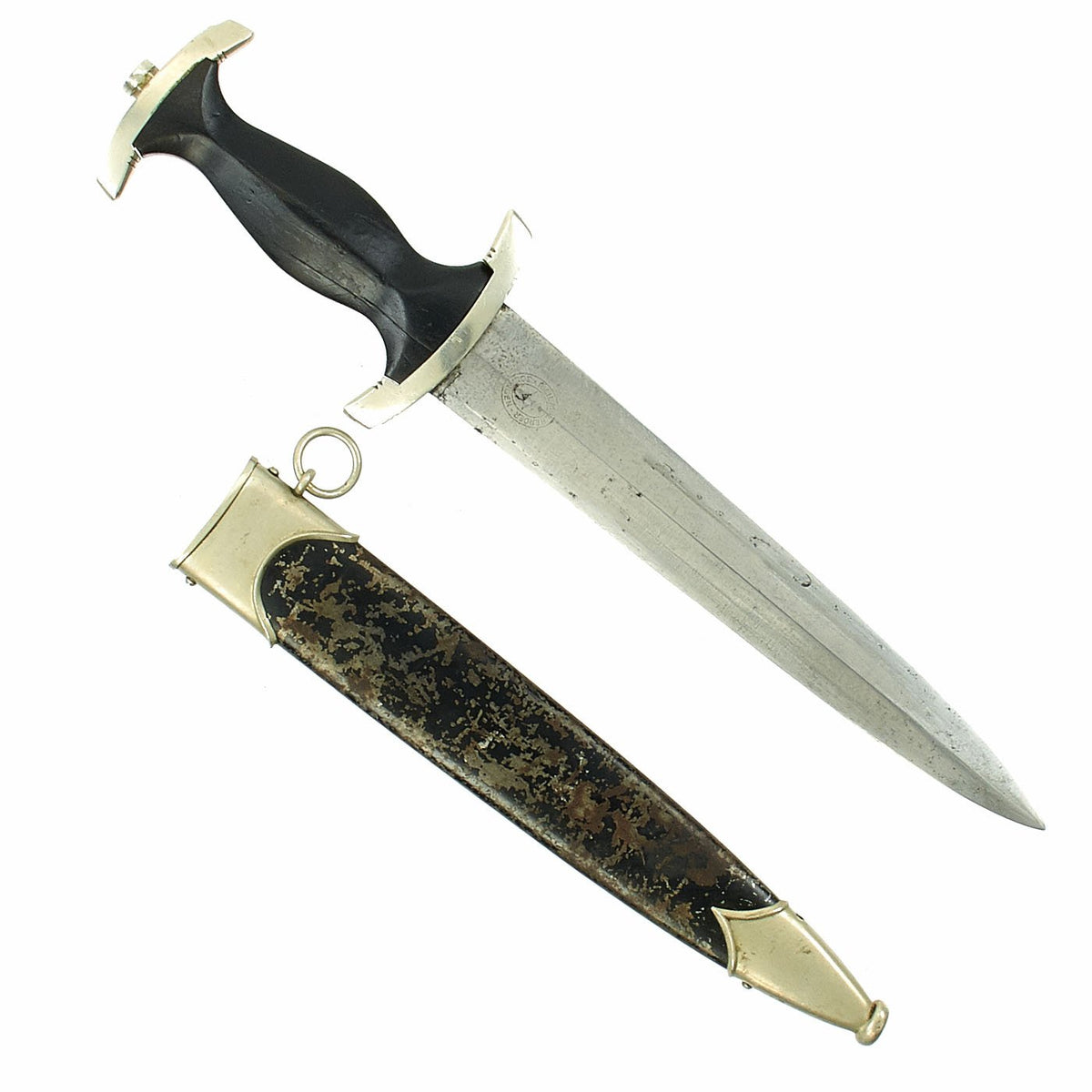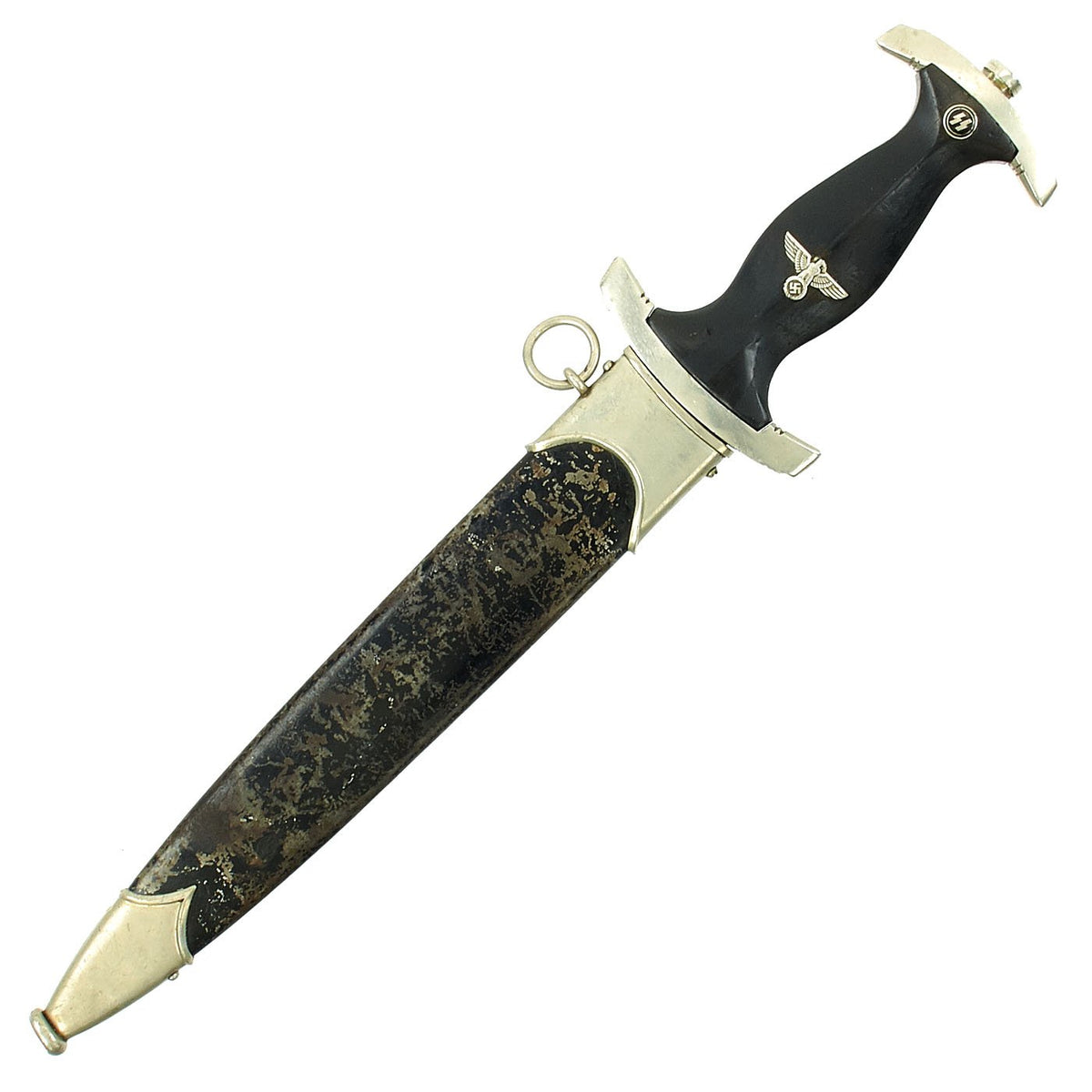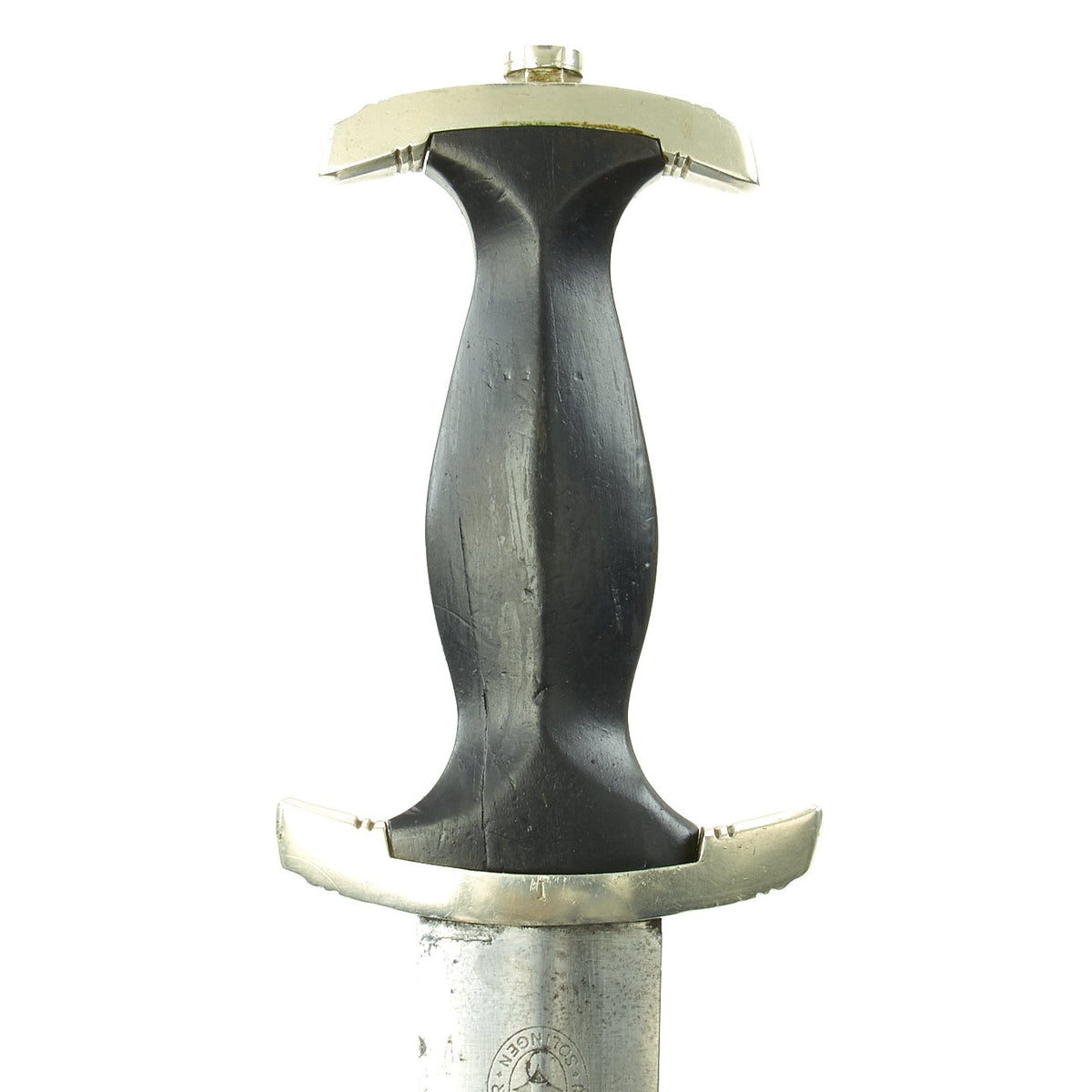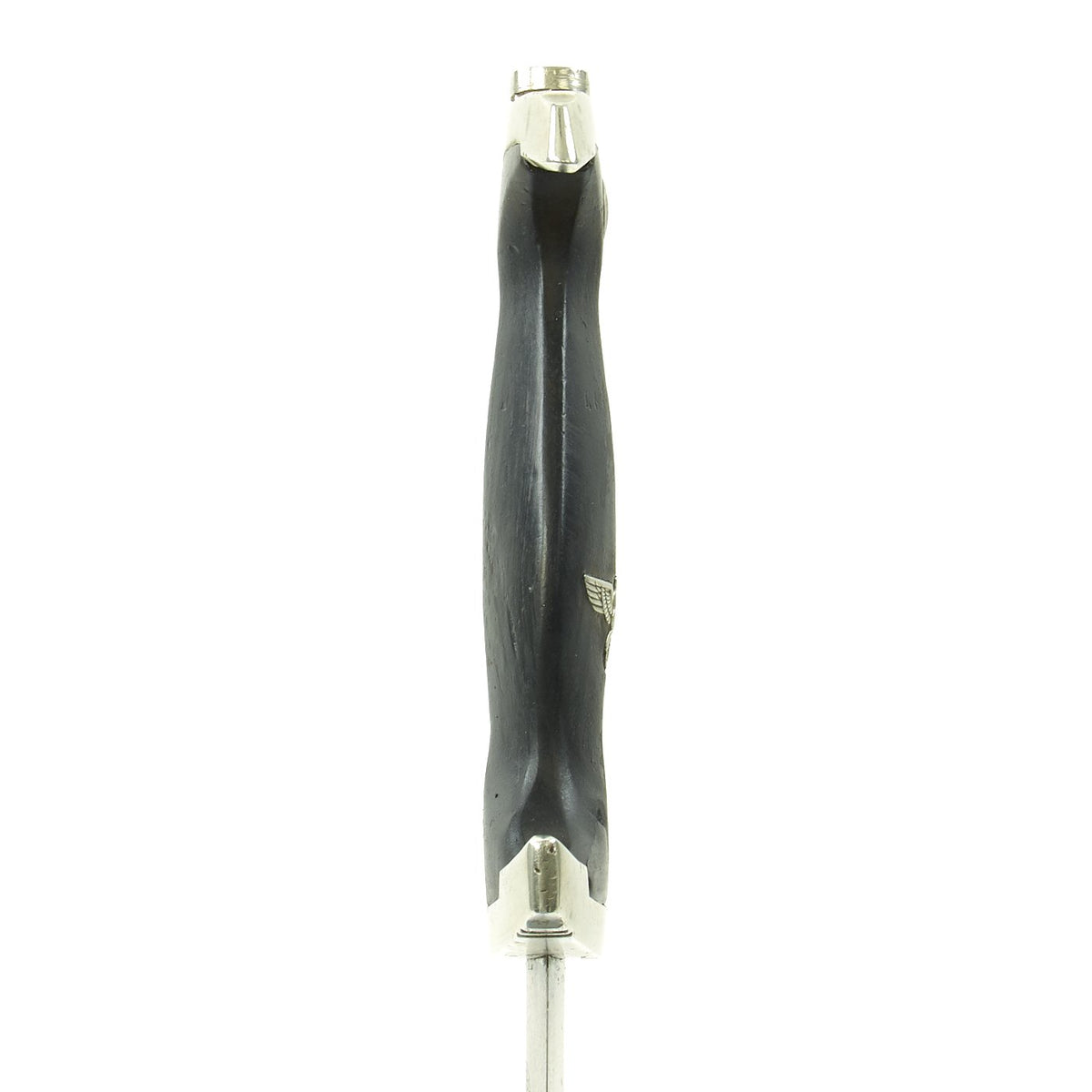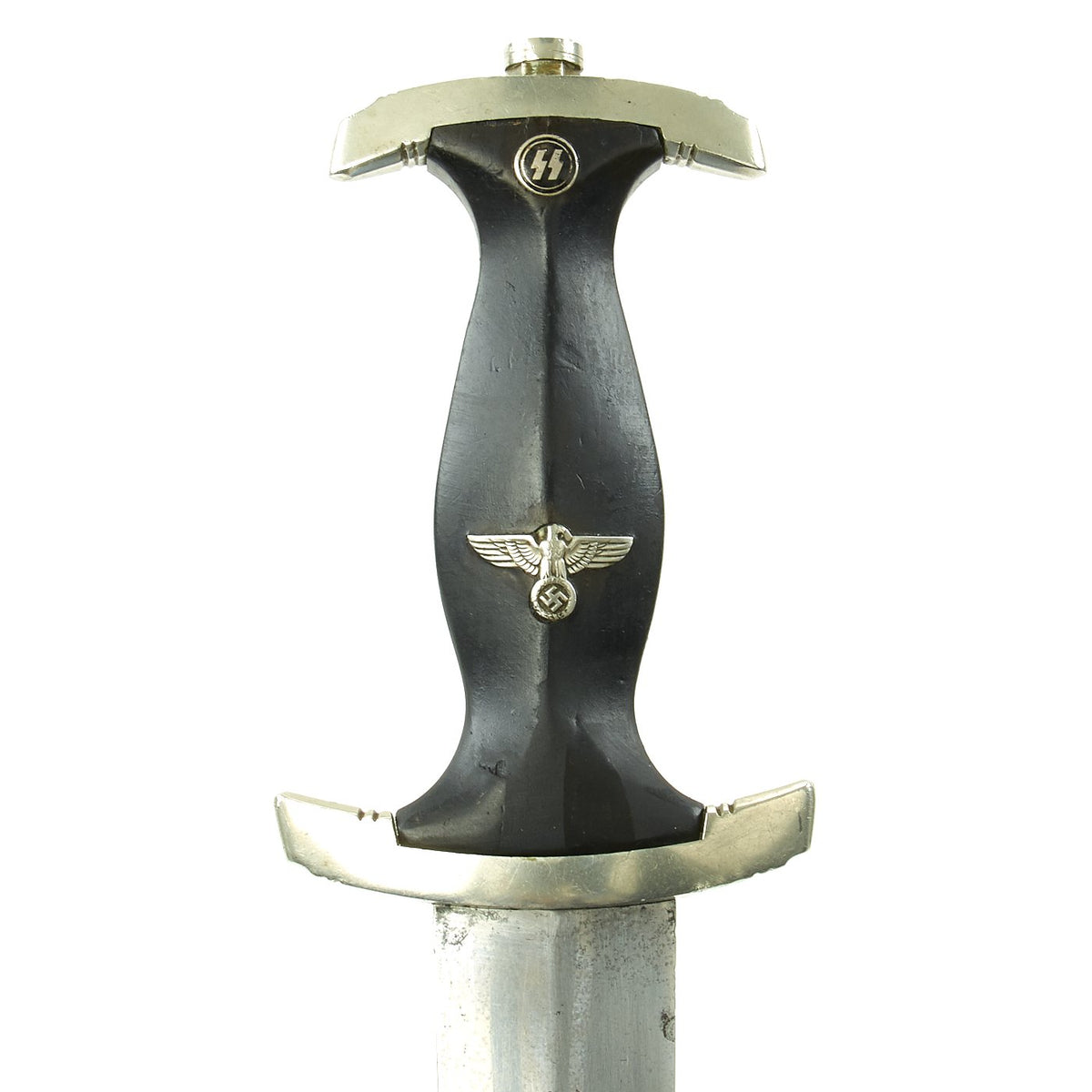Original German WWII Early Model 1933 SS Dagger by Richard Abr. Herder of Solingen Original Items
$ 2.295,00 $ 573,75
Original Item: Only One Available: The SS (Schutzstaffel – ‘Protection Squadron’) was originally formed in 1925, ostensibly to act as a small, loyal bodyguard unit to protect the Führer, Adolf AH. Under the direction of the Reichsführer-SS Heinrich Himmler, the SS grew to be the most ruthless and feared organization of the 20th century. They were the vanguard of NSDAPsm and eventually controlled nearly every function of German life and much of Occupied Europe. The SS dagger was introduced in 1933. Early on, members of the SS were awarded their daggers during a ceremony at the Feldherrnhalle Memorial in Munich. The annual ritual, charged with mysticism and meant to evoke the traditions of medieval Teutonic knights, was held on 9 November, the date of the unsuccessful Munich Putsch of 1923. Both officers and enlisted men wore the identical dagger until 1936. After this time, only enlisted men wore the M1933 dagger.
The SS Dagger was equipped with nickel crossguards with an ebony wood grip. The black grip contained a National eagle with swas insignia recessed in the center area and an SS sigrunne button inset at the top. On early examples the scabbard shell surface was factory blackened using a metal bluing process. The scabbard had nickel mounts. The SS blade was a polished type containing the SS motto, Meine Ehre Heisst Treue (My Honor is Loyalty). Early examples bore one of three district stampings on the lower reverse crossguard of I, II, or III. Early examples were mostly hand-fit. Production of later examples was more standardized, using cheaper, nickel-plated fittings with black painted scabbard shells. They could be held with a standard belt hanger, or a much rarer vertical hanger.
This fine early example was produced by a well-known maker: Richard Abraham Herder, located in Solingen. This is a known producer of SS daggers during the Pre-WWII period and after. The rear of the dagger is marked with their oval trademark logo:
RICH. ABR. HERDER
(DIAMOND LOGO)
SOLINGEN
The Herder name is well known in Solingen, and this branch originally registered in 1884 as a steelware maker. As time went on they specialized in Drop Forging, and supplied blade blanks to Erfurt Arsenal and other companies. During the Third Reich period, they continued to make their own edged weapons, as well as supply blades to smaller makers. The “oval” style trademark was specifically used on the blades of early SS and SA daggers made during the Third Reich, per J. Anthony Carter’s work GERMAN KNIFE AND SWORD MAKERS.
The blade remains partly bright, with some areas of oxidation and scuffing. It still retains a lot of the factory cross grain, but it definitely has been cleaned and polished in areas. There is also the usual finish degradation from runner marks, as shown. This blade still grades in very good condition. The SS motto, Meine Ehre heißt Treue (Loyalty is my Honor) is crisp with little wear. About 50% of the factory blackening is in the letter fonts in the backgrounds. The edge of the blade does not show any non factory sharpening, and is still in great condition, with no major nicks or dents. The blade shoulders perfectly meet the lower crossguard contour, and is solid in the grip.
The crossguards of this dagger and tang nut are in good condition throughout, and are of the earliest solid nickel silver construction. They have smooth surfaces, but do show wear and some areas of damage and wear. The upper guard is marked with a Roman numeral I, for the third SS district. There is no lifting of the finish, even around damaged areas, showing these are indeed solid nickel silver.
The ebony grip is a nice example showing in good shape, though there are some areas which were cracked/chipped and later repaired. We do not know if this was done at arsenal, but it is most likely post war. The treatment to stain the wood black unfortunately over time makes the wood very brittle, so cracks and chunks missing is common. The symbol button is positioned at about 7:00 o’clock, as it should be. The silvered SS symbol and double circles around them have a nice matching patina with the nickel still intact, with a little verdigris. There is however some chipping in the enamel. The nickel grip eagle is the “high-necked” type with the beak pointing slightly up. It remains in crisp condition, showing little wear to the bird’s head, breast and wing feathering and to the talons, wreath or swas.
The scabbard shell is a solid example being straight as an arrow with a few small dents. It was originally anodized black steel, but that was at some point long ago painted over with black enamel, which is now chipped away in areas, showing the remains of the original anodized finish. The matching solid nickel silver scabbard mounts are in good condition. The lower ball has been crushed in and is split, due to the weaker nickel alloy used in early models (later ones used steel).
An excellent chance to own a very good condition early SS dagger by a very rare Solingen blade maker!
Fast Shipping with Professional Packaging
Thanks to our longstanding association with UPS FedEx DHL, and other major international carriers, we are able to provide a range of shipping options. Our warehouse staff is expertly trained and will wrap your products according to our exact and precise specifications. Prior to shipping, your goods will be thoroughly examined and securely secured. We ship to thousands clients each day across multiple countries. This shows how we're dedicated to be the largest retailer on the internet. Warehouses and distribution centres can be located throughout Europe as well as the USA.
Note: Orders with more than one item will be assigned a processing date depending on the item.
Before shipping before shipping, we'll conduct a thorough inspection of the items you have ordered. Today, the majority of orders will be delivered within 48 hours. The delivery time will be between 3-7 days.
Returns
The stock is dynamic and we cannot completely manage it because multiple stakeholders are involved, including our factory and warehouse. So the actual stock may alter at any time. It's possible that you may not receive your order once the order has been made.
Our policy is valid for a period of 30 days. If you don't receive the product within 30 days, we are not able to issue a refund or an exchange.
You can only return an item if it is unused and in the same state as the day you received it. You must have the item in its original packaging.
Related products
Uncategorized
Australian WWII Owen MK1 Machine Carbine SMG Custom Fabricated Replica with Sling Original Items
Uncategorized
Uncategorized
Uncategorized
Uncategorized
Uncategorized
Armoured Fighting Vehicles of the World: AFVs of World War One (Hardcover Book) New Made Items
Uncategorized
Uncategorized
Uncategorized
Band of Brothers ORIGINAL GERMAN WWII Le. F.H. 18 10.5cm ARTILLERY PIECE Original Items
Uncategorized
Uncategorized
Uncategorized
Uncategorized
Uncategorized
Uncategorized
Uncategorized
Armored Burgonet Helmet & Polearm from Scottish Castle Leith Hall Circa 1700 Original Items
Uncategorized
Uncategorized

